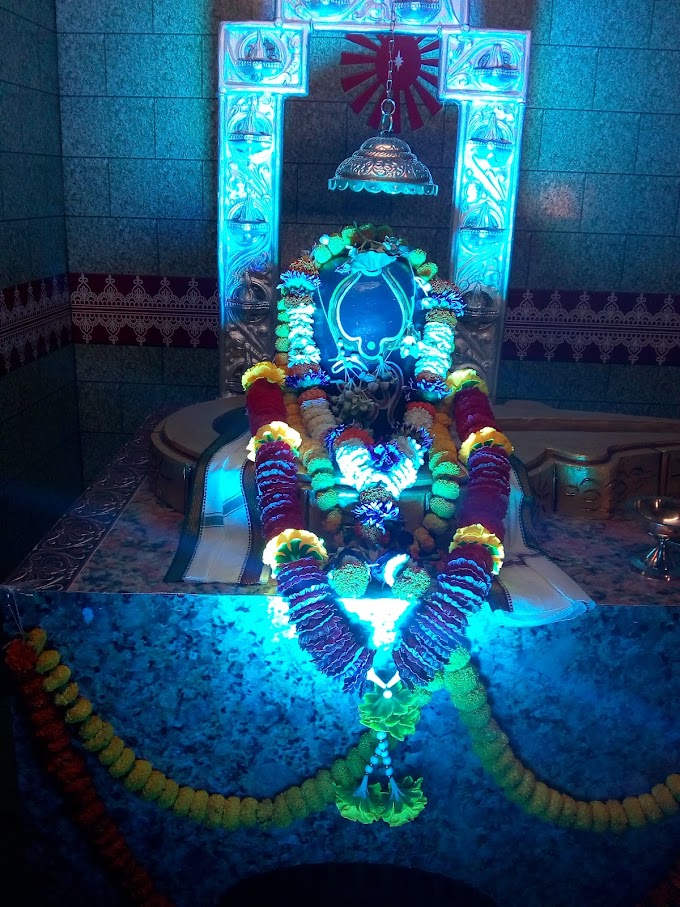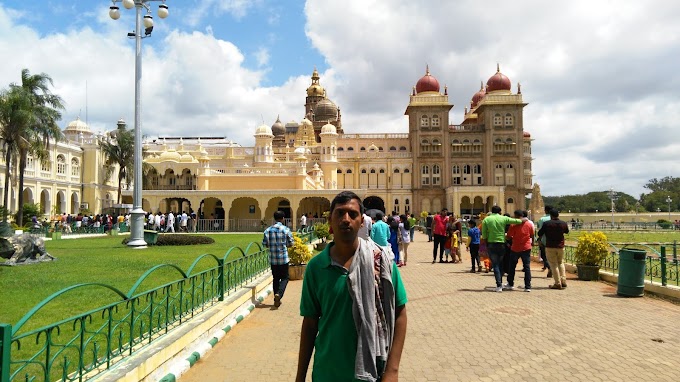According to Hindu mythology, there are 33 Crore Gods. As per mythos, Lord Shiva is one of the most important Gods of Hindu. Lord Shiva is called as Nirakaya (limitless / immeasurable). According to Vedas, the nature of Lord Shiva is destructive and lord Shiva worship as Linga (Shiva linga) or statue of Lord Shiva. Lord Omkareshwar is one of Jyotirlinga. Here lord Shiva is called in name of lord of OM Sound.
The star of all tourist attractions in the town is undoubtedly the Omkareshwar Temple. It is considered to be one of the holiest shrines in India. One of the revered 12 Jyotirlingas in the country, this beautiful structure stands atop an island called Mandhata in Madhya Pradesh. Surrounding it is the confluence of the mighty Kaveri and Narmada rivers.
HINDU SCRIPTURES
According to Hindu scriptures, it is believed that the auspicious marriage the daughter of Vanasur (Usha) and her grandson of Lord Krishna (Anirud) was arranged in this temple. Another legend pertaining to the temple is that of Mandhata, an emperor and (ancestor of Lord Ram) who left all worldly pleasures and performed penance for 12 years by standing on one leg. At the end of his penance, Lord Shiva appeared in the form of Omkar (sound of Om) and blessed him. Since then, the temple is known as Omkareshwar temple.
As per the myth, when Narad, the great prophet visited to the god of Vindhya Mountains, he was quite raging after knowing that there was no dwelling for Lord Shiva and so, the god of these mountains referred himself to very strict non-indulgences. Lord Shiva was very delighted when the deity of the mountain said that he would make Omkareshwar one of his homes and that's why the place is dedicated to Lord Shiva. Over and above, the entire area of this holy place is bordered by mountains, making an enchanting view for travellers.
The second story relates to Mandhata and his son's penance. King Mandhata of Ikshvaku clan (an ancestor of Lord Ram) worshipped Lord Shiva here until the Lord manifested himself as a Jyotirlinga. Some scholars also narrate the story about Mandhata's sons-Ambarish and Muchukunda, who had practiced severe penance and austerities here and pleased Lord Shiva. Because of this, the mountain is named Mandhata.
ABOUT TEMPLE
The famous Jyotirlinga at the Omkareshwar Temple is installed on the foundation floor of the temple and remains immersed in water. The temple is situated at Mandatha Island on the banks of Narmada Kaveri River (a tributary of Narmada). The temple comprises a Sabha Mandap (meeting or prayer hall), which stands on 60 towering brownstone pillars that are 14 ft high. These pillars contain elaborate carvings of frieze, as well as a group of figures resembling Satyrs with broad shoulders and meditating foreheads. On the entrance door, you will find a copper plate on which the history of the temple has been inscribed. The windows of the temple consists of bars which are built with panchaloha. In between the window bars, alphabet ‘lim’ are placed.
It is situated in the Khandwa district of Madhya Pradesh state in India. It is about 12 km from Mortakka in Madhya Pradesh. Omkareshwar is formed by the sacred river Narmada. This is one of the most sacred rivers in India and is now home to one of the world's biggest dam projects.. The island is 2.6 km2 (2,600,000 m2) in area and can be approached by boats and bridge.
WORSHIP
With five stories dedicated to different deities, the temple emanates a sacredness and purity seemingly multiplied five times over. There are three regular Pujas performed in the temple. The temple trust conducts the first one in the morning. The second Puja is presided by the priest of Scindia state, while the priest of the Holkar state performs the third Puja in the evening. The temple is visited regularly by an ocean of pilgrims, especially during major festivals such as Mahashivaratri. One can find devotees bathing in the Narmada or carrying pots full of Narmada water, coconuts, and other items of worship. Abhishek (special worship) is performed three times a day with milk and fruits, curd, and Narmada water. Pilgrims in inconceivable numbers visit the shrine each year to seek the blessings of Lord Shiva. It is a shrine not only for the faithful but for Hindu culture, history and archaeology buffs as well. Scattered around the vicinity are around 20 shrines devoted to deities such as Ganesh, Narmada, Shani, and Krishna.
The religious or spiritual practice to that Omkareshwar Temple is deemed incomplete without having walked the Parikrama or a 16 km circumambulation path that goes around this island. A common practice in most holy shrines, pilgrims not only visit a temple but walk around the sacred Kshetra or region as an absolute sign of devotion. The path around the Kshetra generally takes you around temples, ashrams, and villages.
MYTHOS BEHIND THE CONSTRUCTION OF TEMPLE
In 18th century, King Lingarajendra II built Omkareshwara Temple as a sign of his self-punishment. As per the legend behind the temple, King Lingarajendra II for his political gains had killed a brahmin who has noticed his misdoings. King, who was desperate to attain mental peace by appeasing the Brahmin’s spirit, followed the advices. He then, brought the holy Shiva Lingam from the spiritual town of Kashi. The Shiva Lingam was named Omkareshwara and installed in the temple. Hence, the temple is now known as Omkareshwara temple.
However, later the spirit of brahmin is said to take the form of brahmaraksha who in turn bothered the king for his cruelty. Hence, post the death of brahmin, khe King started having nightmares which troubled him to a great extent.
Omkareshwar temple in Mandhata is located on an pranva shaped (shape like “ॐ”) island at Narmada. Mamaleshwar (ancient name Amareshwar) temple is located on the south coast. Both the temples are described as equal status. Both of these Shivlingas are considered as Jyotirlingas. 75 kms from Khandwa, Indore-Khandwa Highway. This is a very ancient holy place for Hindus. One of the 12 Jyotirlingas of Omkar-Mamaleswar and sidhdhawar kut of Jain are located in this place. Millions of devotees of both religion and foreigners visitors are coming to the place every year.
The cave of Govind ji, the Guru of Adiguru Shankaracharya (Philosopher of supreme theory of Advaita), ruins of the grand temple of Siddhnath, Temple of Gauri Somnath, and rinkmukteshwar Temple are situated at this place. Tirtha Siddawarakut of Jainism is also located nearby. At this place many ancient temples of Jainism are situated, some of them have been renovated. Some images depots that this place exists since 1488 AD.
JYOTIRLINGA
As per Shiv Mahapuran, once Brahma (Father of creation) and Vishnu (God of Protection and Care / Palanharak) had an argument in terms of supremacy of creation. To test them, Shiva pierced the three worlds as a huge endless pillar of light, the jyotirlinga. Vishnu and Brahma split their ways to downwards and upwards respectively to find the end of the light in either direction. Brahma lied that he found out the end, while Vishnu conceded his defeat. Shiva appeared as the second pillar of light and cursed Brahma that he would have no place in ceremonies while Vishnu would be worshipped until the end of eternity. The jyotirlinga is the supreme pathless reality, out of which Shiva partly appears. The jyothirlinga shrines, thus are places where Shiva appeared as a fiery column of light. Originally there were believed to be 64 jyothirlingas while 12 of them are considered to be very auspicious and holy. Each of the twelve jyothirlinga sites take the name of the presiding deity – each considered different manifestation of Shiva. At all these sites, the primary image is lingam representing the beginningless and endless Stambha pillar, symbolizing the infinite nature of Shiva.
It is spiritually fitting that Omkareshwar lies strategically midway between the path of the Narmada from its source at Amarkantak to its final destination near Bharuch in the Arabian Sea. Believed to be the ‘Nabhi Sthal’ or the navel of the river, Omkareshwar is the perfect location to begin and end the Narmada Parikrama. It is a crucial step on the spiritual Narmada Parikrama Journey, even for pilgrims who start from the source.
The quiet town of Omkareshwar in Madhya Pradesh is a spiritual hub, especially for Shiva devotees across the country. A beautiful riverside pilgrim destination in Madhya Pradesh, ‘Omkareshwar’ means ‘Lord of Omkara’ – one of the Dwadasa Jyotirlinga shrines or the 12 shrines dedicated to Lord Shiva in the form of a Jyotirlinga. Millions of pilgrims visit this small town for the sacred Jyotirlinga at the Omkareshwar temple. Besides its popularity as a pilgrimage center for Hindus, the town is also known for a hanging bridge over the Narmada river called ‘Jhula Phul’ – a splendid sight that serves as a pathway to the Mandhata Temple.
Built in 19th century, in 1820, by King Lingarajendra II presenting an interesting architecture that attracts not only devotees but everyone. Irrespective of which faith you are from, its unique blend of Gothic and islamic architecture is worth exploring. This temple is dedicated to Lord Shiva.
As per Hindu legend, Vindya, the deity controlling the Vindyachal mountain range was worshipping Shiva to propitiate himself from the sins committed. He created a sacred geometrical diagram and a Lingam made of sand and clay. Shiva was pleased with the worship and believed to have appeared in two forms, namely Omkareshwar and Amaleswara. Since the mud mound appeared in the form of Om, the island came to be known as Omkareswar. There is a shrine for Parvati and Ganapati in the temple.
CULTURE
Presenting a unique incorporation of Gothic and Islamic architectural styles, Omkareshwara Temple is a sight worth exploring.. Apart from seeking blessings of the Lord Shiva, tourists can admire its different style of architecture, which in some manners, is similar to a islamic Dargah as the temple consists of a huge dome in centre and four minarets that surround its four corners.
MAP
Omkareshwar temple is situated in lower side of Ukhimath town, on the Gopeshwar-Mandal road. It is located 2kms form the Ukhimath taxi stand. GMVN Ukhimath is located near the temple. Rishikesh is the nearest railway station – 175 kms away from Ukhimath, while Jolly Grant airport in Dehradun is the closest airport at a distance of 195 kms from Ukhimath.
For those who want to travel at leisure, while exploring the route to Madikeri, can hire a taxi to drive their own cars. It takes around 5 hours and 30 minutes (265 km) by road from Bangalore to Madikeri.











